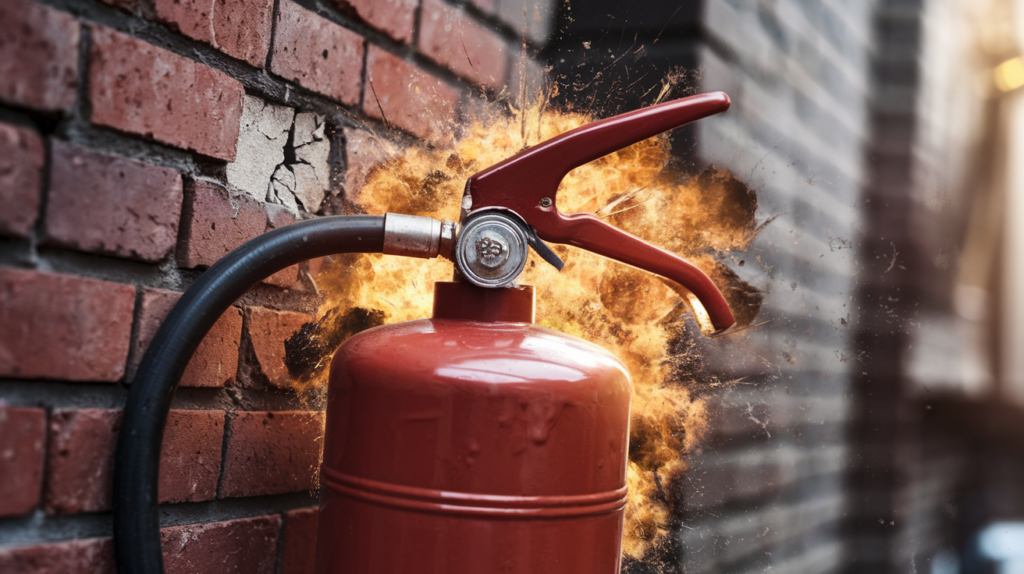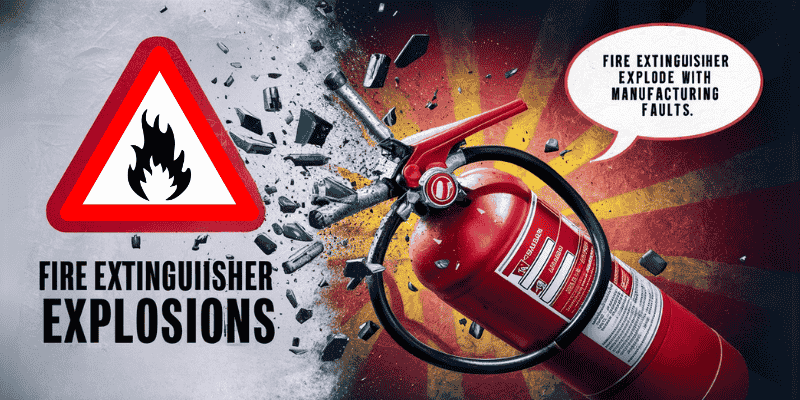Fire extinguishers are probably the most general equipment found in a house, a company workplace, and any other public domain. They regulate small fires in controlled areas before becoming huge catastrophes. This market is valued at $4 Billion and is expected to rise up to $7 Billion. Fire extinguishers also become dangerous once not cared for properly or stored away. This blog will explore can fire extinguishers explode.
Can Fire Extinguishers Expire?
Yes, fire extinguishers also have an expiration date. They look so simple and static, yet they carry pressurized materials. These materials might degrade over time, and this may affect how effective they can be in extinguishing the fire at the proper time. Imagine the chemicals within that extinguisher degrade just as food stored in the pantry shelf does. This would deteriorate that fire extinguisher, therefore causing a weakness in efficiency towards quelling that fire.
Other than this, seals as well as other parts of this extinguisher may also weaken or break due to temperature, frost, or minor tears. All these may develop leakage issues, malfunction, or even cause safety failure: for example, unintended leakage or explosion in extreme events. Regular Fire Extinguishers Service is crucial to address these issues and ensure the extinguisher remains functional and safe.
Can Fire Extinguishers Be Refilled?
It can be refilled easily by a professional after being used. Poor refilling of fire extinguishers could easily make it fail and raise the possibility of fire extinguisher explosion.
The following points will be explained how can fire extinguishers explode:
Damaged Functionality
Faulty refilling of extinguishers may affect the internal pressure within an extinguisher and the distribution of the extinguishing agent, thus failing at the critical moment.
Risk of Explosion
Overfilled fire extinguishers may burst or even blow up due to low pressure or contamination.
Warranty Invalidated
Most fire extinguishers come with a guarantee. Overfilling your extinguisher will automatically annul those guarantees. Thus, you will never get anything from the extinguisher if it fails.
For your fire extinguisher to be safe and efficient, always request a qualified professional to refill them. Fire Extinguishing Methods these are professionals equipped with training, equipment, and the necessary skills that will allow them to operate the refilling process properly.
Can a Fire Extinguisher Explode?

As much as this is less likely, it is, however, possible. The following conditions may be associated with these explosions.
It can overheat
If one leaves it under too much heat, even direct sun or keeps near sources of heat, one increases the pressure inside this extinguisher. It may cause its cylinder to break open and even trigger an explosion with the fire extinguisher.
Physical Impact
Dropping or knocking it can damage the fire extinguisher’s cylinder, Fire Extinguisher Sizes Chart which will increase the chances for a breakage.
Malicious Treatment
Sometimes, the fire extinguisher may be maliciously treated; that is, somebody handles it upside-down, and the movement of its varied parts might displace pieces, resulting in accidental discharge of contents or explosion of the fire extinguisher.
Manufacturing Faults
Though hard to believe, defects caused by manufacturing flaws have been found, which cause weaknesses in the design, such that it becomes weak, which is why pressure failure takes place.

Aging and Degradation
The components in a fire extinguisher corrode with time. That means that the parts begin to leak, eventually causing a malfunction that leads to fire extinguisher explosions.
How to Avoid Explosions With Your Fire Extinguisher?
1. Storage
- Temperature Control: Unsuitable temperatures can significantly affect the internal pressure of a fire extinguisher. They should not be exposed directly to sunshine, high temperature, or freezing. Instead, they should be left at a medium range.
- Ventilation: There is a need for proper ventilation around stored extinguishers. This would prevent gathering heat and moisture that raise the internal pressure of fire extinguishers.
- Accessible Area: The space around the extinguisher must be free from obstacles so that the obstacles concerning access are not encountered in emergencies.
2. Safe Operation
- Impact Prevention: Throwing, jerking or dropping the extinguisher on rigid surfaces will result in the shattering of the cylinder and, hence, damage to the cylinder integrity. Therefore, avoid impacts to minimize mechanical damage.
- Do Not Shake: Externally, it may shake the parts up inside the extinguisher, leading to leakage unintentionally inside the cylinder.
- Mounting Vertically: Place it vertically so that leakage will stop; the pressure inside will then be reasonable and right.
3. Maintenance
- Monthly Visual Inspection: The Role of Monthly Fire Extinguisher Inspections is to check for potential damage, corrosion, leakage, or missing parts.
- Professional testing Annual: The professional tests the extinguisher every year to determine if it is filled up and working with no defect inside. A technically qualified technician will find possible faults and correct them even before accidents happen.
- Refill Professionally: If your extinguisher requires refilling, have it done by a qualified technician. Improper refilling can compromise the effectiveness of the extinguisher and make the possibility of malfunction or even explosions more likely.
4. Know Your Extinguisher:
- Read Instructions: Familiarize yourself with the instructions and operating procedures required for using the fire extinguisher.
- Be realistic: Fire extinguishers are only to be used for small fires. It is crucial to get professional help to stop a fire from moving too fast.
When Should Fire Extinguishers Be Inspected?
Fire Extinguisher Inspection is meant to be performed at some interval. That means two major levels of Fire Extinguisher Inspections should be conducted:
1. Monthly Visual Inspections:
- Objectives: These are general inspections that would reveal any weak point that would impact performance
- Procedure: Literally anyone can conduct this. Check if there are signs of rust, corrosion, leakage, or choking near the fire extinguisher. Check on the pressure gauge and whether the tamper seal of the safety pin is intact
2. Annual Professional Inspection
- Objective: These are thorough checks made by experts to identify the inner condition of the extinguisher and to ascertain its working condition.
- Operation: Experts will check whether there are faults, leakages, and proper fillings of the extinguishers. They will check for pressure tests and carry out part exchange if necessary.
3. Other Considerations
- Frequency: The frequency of inspection may depend upon the local regulation, the kind of extinguisher, and the environment in which it is used.
- Record Keeping: It should be recorded for every inspection. The date of inspection, findings, and what kind of maintenance was done should be recorded.
Frequently Asked Questions
What causes a fire extinguisher to explode?
Well, many such reasons may lead your fire extinguisher to this explosion. Overheating, physical damage, wrong handling, manufacturing flaws, and old age.
Can a fire extinguisher be refilled after use?
Most of the fire extinguishers can be refilled. But under the hands of only an expert, professionally certified person
How can I prevent a fire extinguisher explosion?
Keep the fire extinguisher away from sunlight and electrical sources. How to Inspect a Fire Extinguisher They require extreme care. Their periodical inspection has to be maintained and filled out by an expert professional.
How do I know if my fire extinguisher is safe to use?
The following steps will lead you to decide its usability accurately.
- Carry out periodic visual checks
- Annual check by a professional
Are fire extinguishers required by law?
Having fire extinguishers depends on the laws and regulations of the location. In most countries, many states require businesses and owners of public buildings to have a readily available fire extinguisher.
Also Read: Why Must Fire Extinguishers Be Routinely Maintained
